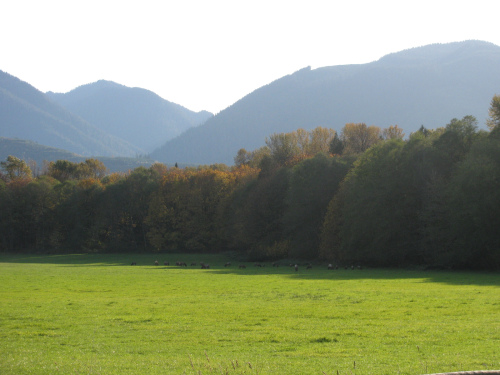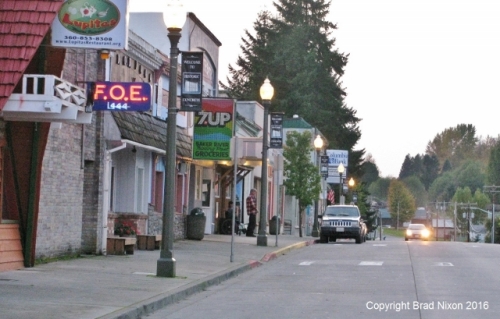One of the rules of traveling with Dad is that one must NOT have an itinerary that is too well-defined or pre-planned. Above all, one will NOT reserve accommodations in advance. His assumption is that if you already know where you’ll end up, you might have to miss something bodacious in order to get to where you’re staying, or you might stop just before you discover that five more miles would put you in the spot you really want to see. This approach is utterly alien to the habit I’ve developed in thirty years of mostly business travel, which assumes that before one steps onto any airplane, one will know precisely where each day will end and that there will be a guaranteed place to park the crew and the gear.
The very first day of our recent trip would prove the wisdom of his approach.
As we embarked on our week-long exploration of the three national parks of Washington state, we had a daunting itinerary in mind. The general idea involved something like a thousand miles of driving: north from Seattle to North Cascades National Park, then south down the eastern side of the Cascades, west to Mount Rainier, and then a big circle following Route 101 around the Olympic peninsula and back to Seattle. Along the way, we were determined to see the big mountains and their diverse forests, the valley of the Columbia, big ol’ Mt. Rainier, and then the Olympic Range, and the rainforests and coastline of the peninsula, as well as a couple of port towns. Each day required a balance of driving far to cover the ground, but still allowing some flexibility to stop and see what seemed most appealing.
Our first day we drove up Interstate 5 from Seattle, then headed east on Route 20 toward North Cascades. The farther east we went, the less settled the country became, meaning fewer accommodations. “Press on!” the boss said, and we did. We knew that the very last hope of a place to stay would be Marblemount, at the ultimate western edge of the national park. After that, all would be wilderness for another 80 miles. No gas. No food. No lodging. We stopped for a very late lunch in the little burg of Lyman — once a bustling timber town — where our waitress at The Old Mill Restaurant didn’t have a very good grasp of what we might encounter in the way of hostelries. Locals never do, anywhere. They already have a place to stay, so they aren’t much help to the wayfaring stranger. We pressed on eastward up the Skagit River valley.
A few miles further along, we came to a sign that said, “Wildlife Viewing Area Ahead.” Right. As if the local wildlife were going to heed the direction and make certain to be grazing at the appointed spot. Perhaps they have shift assignments: “10 o’clock! Bears, you’re done for the day. Let’s get those elk out here!”
Dad was driving. The Wildlife Viewing Pullout was ahead. As a big, open meadow came in view, I, as navigator, cried, “Pull over!”

There was a herd of about 25 elk, maybe a quarter-mile out across the grass, playing by the rules. Here they are, zoomed in at the limit of my camera.

Very well-trained wildlife there in Washington, obviously.
That word, Skagit, by the way, is pronounced SKA-jit (the “a” is like in “badger”).
About three miles east of the obedient elk herd, we were looking for the next little town on our maps that might offer a place to stay before night took us and the wilderness closed in, Concrete. It wasn’t hard to identify Concrete from the state road.

The town itself was along a single main street (Main Street, of course) that paralleled Route 20, but we had to turn off the state route and detour up to find it. Concrete, Washington.

There in the verdant Skagit Valley, the founders of a town named Baker thoughtfully put the town up on a shoulder of the high country, on the north bank of the Skagit, because the valley was prone to flooding. Another nearby town, Cement City, was eventually merged together and the combined town took the name of Concrete. This settlement is late in U.S. history by most standards, just before 1900, which says something about the remote, rugged nature of the countryside. Humans, of course, had been living there for thousands of years, but the idea of building permanent towns dedicated to commerce in the challenging wilderness was not always the native way of life. But, once Europeans arrived with their commercial bias, the rich stands of timber and the construction of a railroad line just before the turn of the 20th century, followed by the discovery of rich deposits that supported the manufacture of Portland cement, boosted local population through jobs and prosperity.
But it was a prosperity based on removing finite resources, and cutting readily available local timber and mining accessible limestone for cement played out quickly. Once the new state highway went through along the now flood-controlled Skagit, a hundred yards below Concrete’s Main Street, the town was literally left high and dry, withering like thousands of other little burgs made redundant by changing times.
Today, the civic leaders of Concrete are wrestling with the question of how to instill vitality into their tiny town, suspended between the towering mountains and the state route. There’s a bank, a couple of restaurants, both Elks and Eagles lodges, a hardware store, a laundromat, and, thankfully, the Hi-Lo Hotel where Dad and I holed up for the night quite comfortably (and had excellent pancakes at the associated cafe the next morning). Their town, perhaps, shouldn’t exist at all. The industries that promoted the town’s growth no longer operate.
It’s a situation that scores of generations of the original inhabitants would never have encountered. They — the native population — would never have entertained the notion of settling large numbers of people permanently onto land whose resources would soon be exhausted. Industrial Man, inheritor of the 19th Century’s ideas of Progress and Prosperity, didn’t consider the limitations of the world — what we call the Environment today. They built the railroad to haul out trees and Portland cement. They dammed the Skagit to prosper settlement and cultivation in the narrow valley. They built massive silos and schools and bridges. Once the trees were cut and the limestone was dug out and reified, it was done. Concrete’s first buildings almost all burned in a disastrous fire in the early 20th Century and were rebuilt with poured-concrete structures. But there was no thriving trade to support business in the buildings. Scarcely a hundred years later, they are withering along Main Street.

There is always hope, and striving. Town leaders are discussing how to stimulate retail trade and tourism. The original 1923 movie theater has reopened and shows a “first-run” film three days a week, Friday through Sunday. What I like best: One of the business leaders trying to bring life to Concrete has taken an inspiring step: He revived a dormant local newspaper, the Concrete Herald, “The Voice of Eastern Skagit County” (click on the link to see the online version. Give ’em a hit, for heaven’s sake). Inspired? Yes. Visionary? Yes! From London to Paris to Chicago to Omaha and Alexandria, a newspaper is the local force that can connect people and, perhaps, still unite them. I brought a copy home with me. Man, a newspaper!
Evening light strikes the snow-capped peaks above Concrete. They hang, glimmering and vast (apology to M. Arnold), in the far Cascades, a vision of unutterable beauty. There are always dreams. Perhaps Concrete will find a future, attuned to its environment, under a western sky.

This is the third entry in a series of articles about a trip I recently made with my dad to the national parks and wild places of Washington state. To see the first in the series, CLICK HERE, or use the left-right navigation below to move forward and back.
© Brad Nixon 2011, 2017
I’ve never been to Washington. Looks gorgeous though!
http://cobblestonestreets.wordpress.com/
LikeLike
By: Just Be. on November 16, 2011
at 5:06 am
Wow, Concrete, Wa. You know how you read a book and you feel like you’ve been there. Tobias Wolff and This Boy’s Life. It’s assigned reading in HS here, so we had two copies lying around, and I couldn’t resist. Mr. Wolff did well after leaving Concrete, but he had some rough times there.
LikeLike
By: John R Cadwallader on November 16, 2011
at 7:35 am
John, thanks for mentioning Wolff and his novel. I meant to, and forgot. Also a movie with Robert DeNiro.
LikeLike
By: Brad Nixon on November 16, 2011
at 11:03 am
Was that movie Deer Hunter?
LikeLike
By: La Boheme on November 16, 2011
at 11:07 am
No, it was called “This Boy’s Life,” just like the novel.
LikeLike
By: Brad Nixon on November 16, 2011
at 11:26 am
I forgot about the movie, and have not seen it. I see it also stars a young Leo DiCaprio.
LikeLike
By: John R Cadwallader on November 16, 2011
at 5:59 pm
Love your travelogs and photos. Little towns I never knew about, well known places I haven’t visited. Interesting insights, colorful descriptions. Great stuff!
LikeLike
By: La Boheme on November 16, 2011
at 10:19 am
concrete! wow, you’re still in the early stages then, nice shot of the cement elk too!
LikeLike
By: briando on November 17, 2011
at 8:16 am